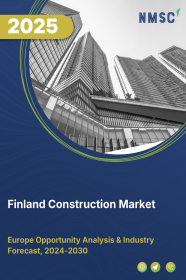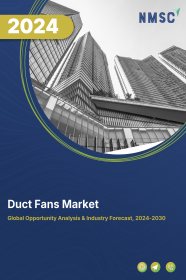
Finland Construction Market by Type (Renovation and New Construction), and by Sector (Real Estate, Infrastructure, and Industrial)–Opportunity Analysis and Industry Forecast, 2024–2030
Industry: Construction & Manufacturing | Publish Date: 19-Mar-2025 | No of Pages: 138 | No. of Tables: 108 | No. of Figures: 53 | Format: PDF | Report Code : CM2205
US Tariff Impact on Finland Construction Market
Trump Tariffs Are Reshaping Global Business
Finland Construction Market Overview
The Finland Construction Market size was valued at USD 41.36 billion in 2023, and is predicted to reach USD 51.96 billion by 2030, at a CAGR of 4.2% from 2024 to 2030.
The construction market, also known as infrastructure, plays a vital role in the economy by overseeing the entire lifecycle of various physical structures, including infrastructure, buildings, and facilities. This industry encompasses a wide array of projects, ranging from residential, commercial, and industrial developments to civil engineering and institutional infrastructure endeavors.
Collaboration among various stakeholders, including architects, engineers, contractors, suppliers, developers, investors, and government agencies, is essential for its operations. Positioned for growth, the industry is being driven by an increased emphasis on environmentally sustainable practices, such as the integration of green building materials and energy-efficient designs. Furthermore, factors such as rising per capita income in emerging economies and low-interest rates in developed nations are expected to further propel the expansion of the infrastructure market.
Renewable Energy Infrastructure Initiatives Driving Growth
The construction market in Finland is witnessing notable growth, primarily fueled by the increasing presence of renewable energy infrastructure initiatives. Key projects such as the 475 MW Huittinen solar farm, a planned solar park spanning Kainuu and North Ostrobothnia, and a 500 MW solar project in southern Finland are significant drivers behind the expansion of the infrastructure industry in the nation.
Exceptional Growth of Finland's Infrastructure Sector Boosts the Market
Furthermore, the expansion of the overall market is influenced by the exceptional growth of Finland's construction market, that plays a significant role in the country's GDP. According to a UNECE report, the infrastructure sector accounted for 7.0% of Finland's GDP in 2022, that is a higher contribution than that of other European nations such as Denmark, Ireland, and Netherlands. This significant contribution of the infrastructure sector to Finland's economy is a crucial factor that is pushing the market's overall growth.
Challenges of Regulatory Complexities in Infrastructure Hinders the Market Growth
Navigating through regulatory complexities presents a formidable challenge for the construction market. Infrastructure endeavors encounter hurdles due to the intricate maze of government regulations and permitting procedures. Infrastructure projects require a multitude of permits and approvals from various governmental bodies, spanning local, regional, and national levels.
These permissions involve adherence to zoning regulations, environmental assessments, compliance with building codes, safety standards, and other regulatory requirements. Lengthy permit acquisition processes, bureaucratic inefficiencies, and regulatory variations among jurisdictions can significantly extend project timelines and escalate costs. Moreover, fluctuations in regulations or unexpected policy changes can disrupt ongoing projects and deter potential investments.
Integration of Digitalization and BIM Presents Lucrative Opportunity for Market Expansion
The construction market is undergoing a transformative phase with the integration of digitalization and the adoption of Building Information Modeling (BIM). Leveraging advanced technologies, such as BIM, enhances efficiency, accuracy, and collaboration across diverse projects.
BIM, a sophisticated 3D modeling tool, empowers stakeholders to create and manage digital representations of structures and infrastructure, facilitating better coordination and communication among project teams. For instance, in September 2022, the National Institute of Building Sciences (NIBS) initiated the Finland National Building Information Management (BIM) Program.
This program aims to revolutionize the infrastructure sector, achieving unprecedented levels of industrial efficiency through digitalization. By addressing the inadequacy of digitalization within the Finland infrastructure sector, the initiative seeks to streamline lifecycle work processes, making them more efficient, cost-effective, resilient, and safer for infrastructure and maintenance.
Competitive Landscape
The market players operating in the Finland infrastructure industry include YIT Oyj, SRV Group, NCC, Skanska, Peab AB, Lehto Group, Fira Group, Hartela, Rakennusliike Lapti, Projektinuotit Oy, Destia, Ains Group, Kreate Group Oyj, Consti Group Plc, Vinci SA, and others.
Finland Construction Market Key Segments
By Type
-
Renovation
-
New Construction
By Sector
-
Real Estate
-
Residential
-
Affordable
-
Luxury
-
-
Commercial
-
Retail Buildings
-
Office Buildings
-
Hospitality
-
Healthcare Facilities
-
Educational Institutes
-
Entertainment Ventures
-
-
-
Infrastructure
-
Transportation
-
Airport
-
Port
-
Rail
-
Road
-
-
Water and Wastewater
-
Energy
-
Telecommunication
-
-
Industrial
-
Manufacturing Plant
-
Warehouses
-
Power Plants
-
Oil Refineries
-
Chemical Plants
-
Key players
-
YIT Oyj
-
SRV Group
-
NCC
-
Skanska
-
Peab AB
-
Lehto Group
-
Fira Group
-
Hartela
-
Rakennusliike Lapti
-
Projektinuotit Oy
-
Destia
-
Ains Group
-
Kreate Group Oyj
-
Consti Group Plc
-
Vinci SA
REPORT SCOPE AND SEGMENTATION:
|
Parameters |
Details |
|
Market Size in 2023 |
USD 41.36 Billion |
|
Revenue Forecast in 2030 |
USD 51.96 Billion |
|
Growth Rate |
CAGR of 4.2% from 2024 to 2030 |
|
Analysis Period |
2023–2030 |
|
Base Year Considered |
2023 |
|
Forecast Period |
2024–2030 |
|
Market Size Estimation |
Billion (USD) |
|
Growth Factors |
|
|
Companies Profiled |
10 |
|
Market Share |
Available for 10 companies |
|
Customization Scope |
Free customization (equivalent up to 80 working hours of analysts) after purchase. Addition or alteration to country, regional, and segment scope. |
|
Pricing and Purchase Options |
Avail customized purchase options to meet your exact research needs. |

















 Speak to Our Analyst
Speak to Our Analyst

















